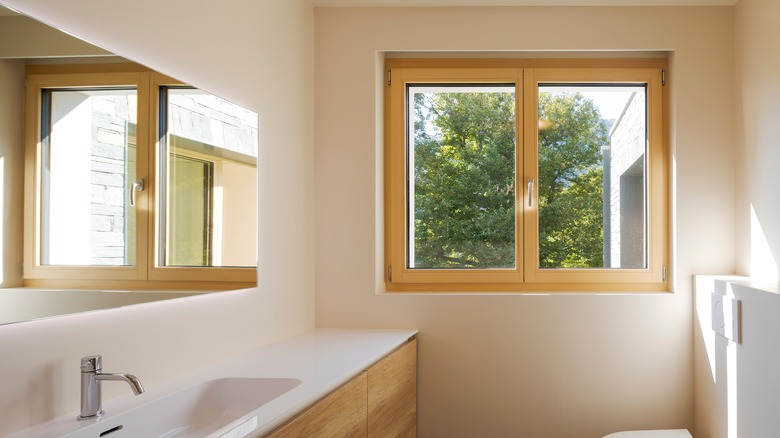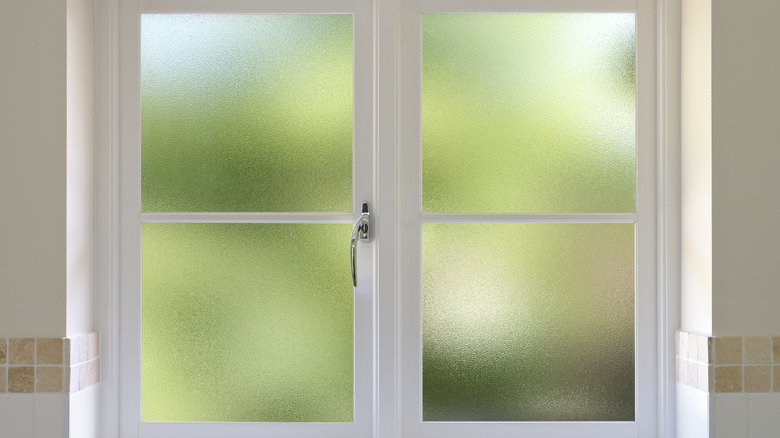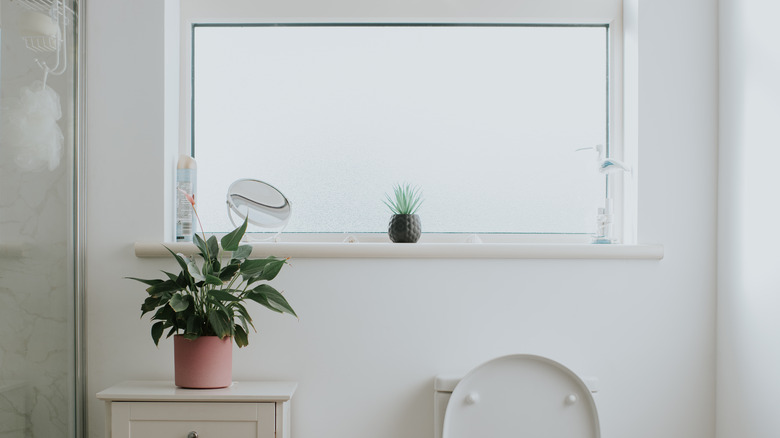What Are The Best Treatments To Use On A Bathroom Window? Here's What We Know
When it comes to designing your bathroom, so much more goes into your decisions than just the theme, paint, or fixtures. Because your bathroom comes into constant contact with moisture, the chances of mold and mildew growth are higher than in other rooms. When it comes to choosing window treatments for your bathroom, material and color matter, and no one understands this more than House Digest's interior design expert Erika Dale, founder of Erika Dale Interior Design. In an exclusive interview, Dale told us all about the best treatments and colors to use on a bathroom window. "My go-to window treatment is typically some sort of privacy glass (or a window film to achieve the same effect) or a water-resistant shade or blind that allows for easy cleaning," Dale explained, noting that neutral colors are best.
Dale added, "The humidity and moisture in a bathroom play a big role in selecting window treatments." This is due in large part to the moisture that collects during bathing, using the sink, and even cleaning. So much contact with steam, water, and general use can cause fabrics to grow mildew, meaning you will have to replace them frequently and are still breathing in the spores collected in the material. Just by replacing fabrics or easily saturated colors, you're creating a boundary against the humidity and moisture buildup. Instead of traditional curtains, there are also other treatments to add privacy to your bathroom windows.
Privacy glass is a good option
Your bathroom might have a lot of square footage, but that doesn't mean that mold growth won't happen. In her chat with House Digest, Erika Dale exclusively shared why taking into consideration what window treatments you use is so important: "Even the most well-ventilated spaces may have mold or mildew issues with gathered fabric window treatments like curtains." She suggested opting for something that doesn't absorb moisture as much. "As always when selecting a window treatment, the ideal selection is dependent on the particular bathroom space, window location, and overall aesthetic," according to Dale.
While it can be tempting to opt for sheer or gauzy curtains that let a lot of natural light in, these can be the biggest culprits of holding on to moisture. "I prefer to select bath window treatments with clean lines, easily wipeable materials, and simple silhouettes," Dale shared. Finding durable window treatments that are easy to clean is a bonus, as they will give you less work over all. She added that "the point is to create privacy, so prioritizing the correct level is crucial, especially when visible outdoors at night (do a test run with a sample before purchasing if possible)."
Consider the window treatment color
When explaining her suggestions, Erika Dale exclusively told House Digest that it's important to find what works for your space but not go overboard, emphasizing that simplicity is key. Dale also noted that taking privacy into account is important. "For example, if you have a tiny room that gets humid quickly and/or a toilet right below a small window, I would be on team privacy glass or window film for the easiest maintenance," she said. "Conversely, if your bathroom is large and well-ventilated, you might have a better setup to handle a moisture-resistant roman shade."
She also reminded homeowners and renters to consider the color of their window treatments. "Because most filter the natural light coming in, it's important to be aware how it's changing the color temperature of the space if that is where you or your guests get ready for the day," she said. Dale recommended to avoid colors that will produce an awkward or unflattering light. She gave readers tips for making the most out of their window coverings. "Neutrals or soft, warmer shades with pink undertones are the most flattering, but most muted warm hues will keep things feeling right," she said. "Avoid overly saturated hues for fear of over-tinting the natural light, as well as anything too dark that may absorb too much of the light coming in, leaving the bathroom overly dim."


